
Range hood sizes: how to measure vent hood dimensions
Range hoods, or vent hoods, help clear out grease smells, moisture and heat to keep your kitchen smelling like home. Finding the right fit shouldn’t be hard: range hood sizes are fairly standardized and based on the size of the cooking surface below. Whether you’re remodeling or just upgrading, use this guide to identify a hood type and size that’s right for your space and cooking habits.
What are standard range hood dimensions?
Range hoods come in standard widths of either 24, 30 or 36 inches. Depending on your cooktop fuel type, vent hoods should be installed 20-30 inches above your cooktop.
What size range hood do I need?
At a minimum, your range hood should be as wide as your stovetop. You can also opt for a range hood that is around six inches wider than your cooktop. Keep in mind that other factors like the venting strength will play a role in which hood you choose.
How wide should a range hood be?
Your new vent hood should always be at least the exact width as your kitchen’s cooking surface. Preferably, your hood should be three inches wider on either side of the cooking surface to capture any additional exhaust during use.
How high should a range hood be above a stove?
If you have an electric cooktop, range hoods should be 20-24 inches above the heat source. For gas cooktops, your range hood should be installed 24-30 inches above the stove. Always refer to your product’s manual for specific clearance measurements. Learn more about how to determine the optimal height of a range hood above your stove to enhance ventilation in your kitchen.
How deep should a range hood be?
Your range hood should extend to cover all back burners and front burners on your cooking station. For most range hoods, 18-22 inches is deep enough for full coverage. However, downdraft vents are slightly larger and require at least 24 inches of depth.
How far can you vent a range hood?
Range hood ducts can be as long as 35 inches if it’s a straight run, and less if it includes one or two elbows. It is not recommended to vent with more than two elbows. The installation instructions for your model should include a formula to calculate the distance you need. Ensure that the duct is long enough to extend outdoors, preventing the recirculation of air back into the kitchen.
Learn more about range hoods and venting options.
What are the different sizes of kitchen hoods?
When you’re shopping for a new range hood, consider which size and style will best suit your kitchen’s layout and design. Discover the different types of vent hoods below.
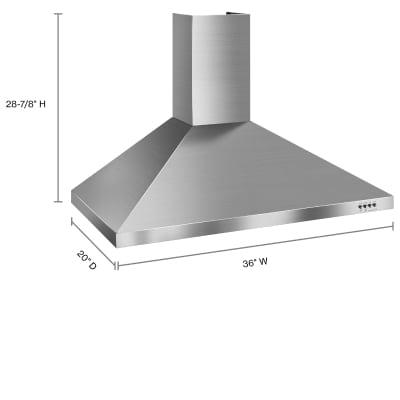
Wall-mount canopy hood dimensions
Wall-mounted canopy hoods can be installed over your range or cooktop against the wall. You may need to remodel cabinets if your kitchen wasn’t designed with one in mind. Typically, canopy vent hoods come in either 30- or 36-inch widths. Canopy range hoods should be at least the same width as the cooking surface below. This can also be about six inches larger than your cooktop, with three additional inches on either side.
Shop Whirlpool® Wall-Mount Canopy Hoods
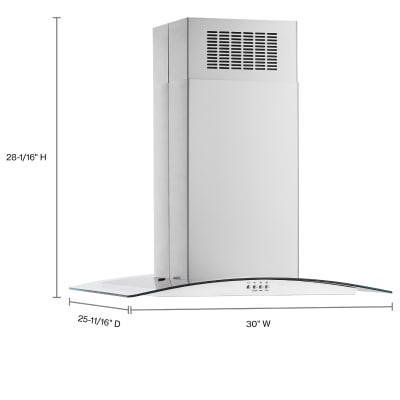
Island canopy hood dimensions
Canopy hoods can also be installed over a kitchen island. They are different from wall-mounted hoods because they’re finished on all sides rather than just three sides. As with the wall-mount canopy hood, this style vent hood should be the same size or up to six inches wider than your cooking surface. Common dimensions for the canopy hood are between 30-36 inches wide, 24-26 inches deep and a height of about 28 inches.
Shop Whirlpool® Island Canopy Hoods
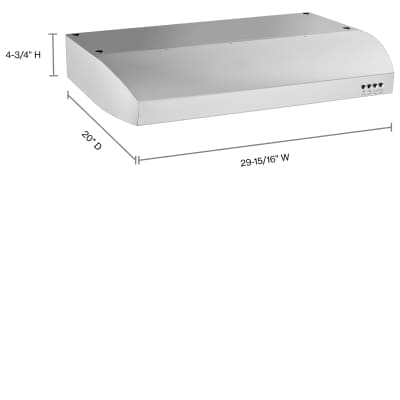
Under-cabinet hood dimensions
These hoods can be installed under a cabinet. They are smaller than a canopy hood but still offer powerful venting. Under-cabinet hoods should fit snugly between cabinets and come in similar widths to canopy hoods. They extend past cabinet depths in order to provide adequate coverage for all the burners on the range or cooktop below. Under-cabinet vent hoods are typically 20-60 inches wide, with the most standard sizes being 30 or 36 inches.
Learn more about wall mount vs. under cabinet range hoods.
Shop Whirlpool® Under-Cabinet Hoods
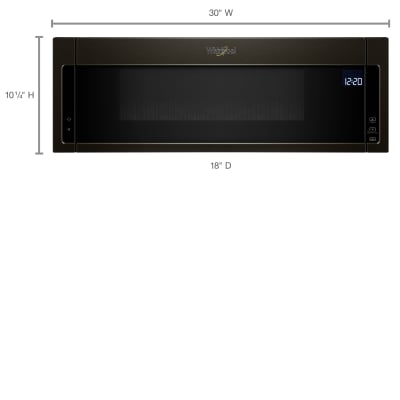
Over-the-range microwave hood combination dimensions
A microwave hood combination can also be used to vent kitchen air. Microwave hood combinations, such as Whirlpool brand’s low profile microwave hoods, can be mounted below cabinets to allow for more storage space and, of course, will also cook food. Over-the-range microwave sizes will be determined by the cabinet space you have. Generally, standard over-the-range microwaves will be 30 inches wide, while compact models measure 24 inches wide. With the door closed, depths can range from 15-18 inches, but can extend to 42-45 inches with the door opened. Be sure to allow for at least 17 inches of height before installing, or 10 inches for low-profile microwave hoods.
Learn more about dimensions in this microwave sizes guide.
Shop Whirlpool® Microwave Hood Combos
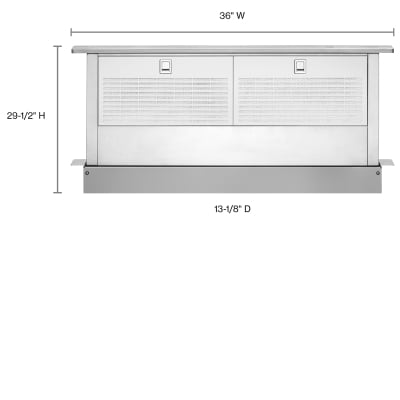
Retractable downdraft hood dimensions
Downdraft hoods are installed directly into countertops and vent air down into ductwork beneath the floor. They should fit flush with countertops but are raised up when it’s time to cook. Downdraft hoods often match the width of the cooking surface and are only a few inches deep. However, they will rise up around 14-18 inches behind the range or cooktop. Learn more about the different types of range hoods.
Shop Whirlpool® Downdraft Hoods
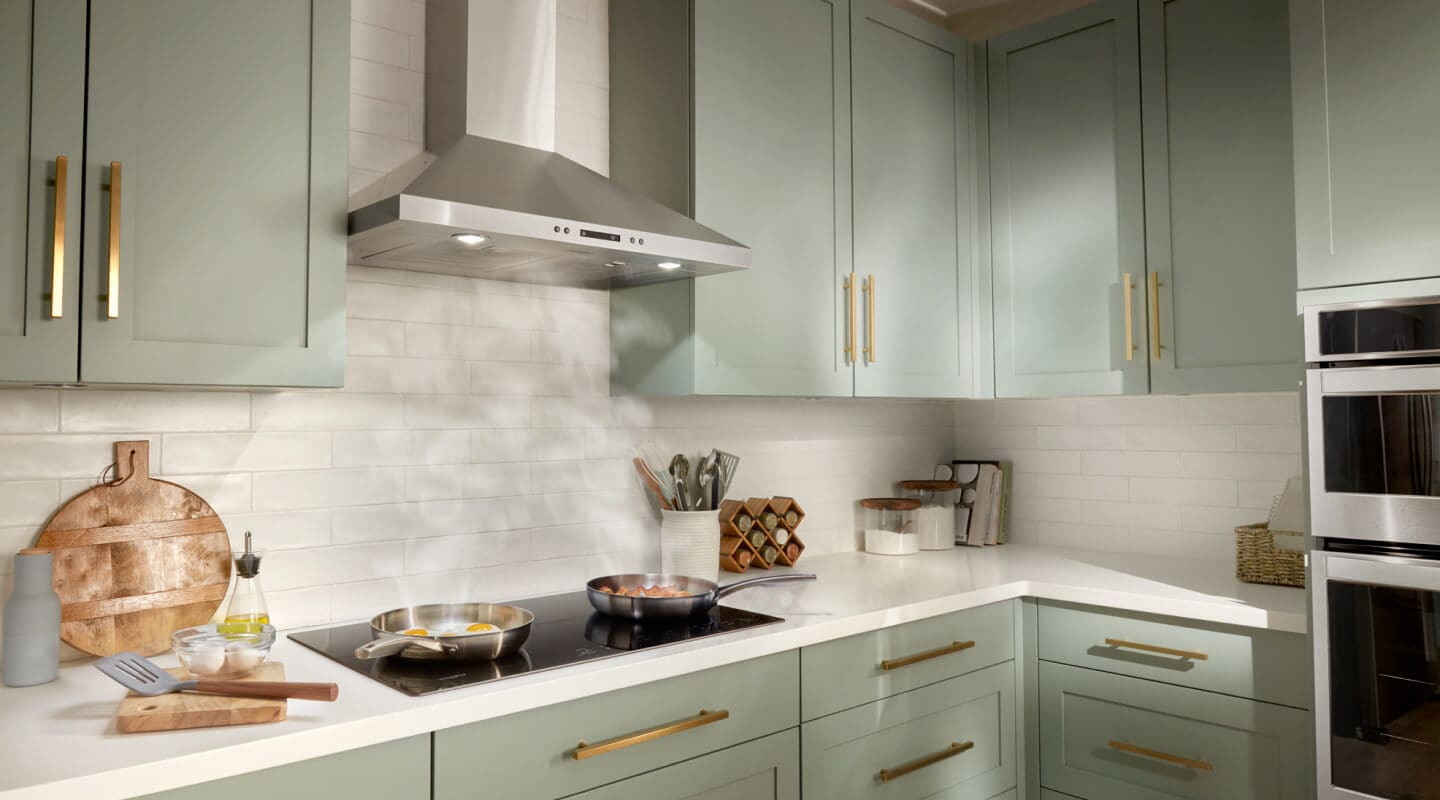
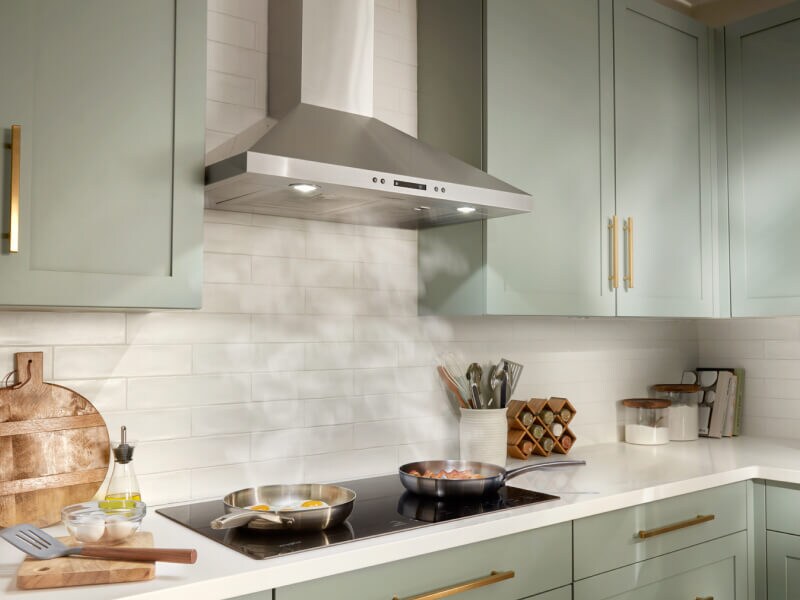
How to measure for a new vent hood
Before you make your range hood selection, you have to ensure that you’re choosing the right size for your kitchen. Follow these step-by-step instructions below to properly measure for your new range hood.
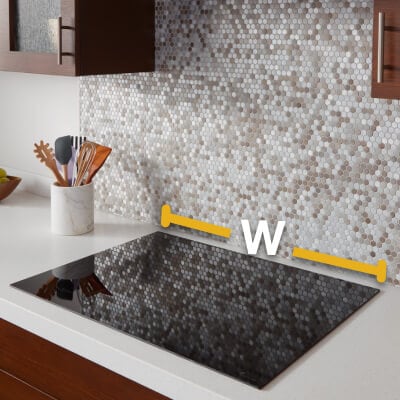
Step 1: Measure the width of your cooking surface
The majority of residential ranges and cooktops are 30 to 36 inches wide, though some smaller kitchens may use a 24-inch cooking surface. If you’re measuring for a downdraft hood, the hood should match your range width exactly and be installed directly behind it.
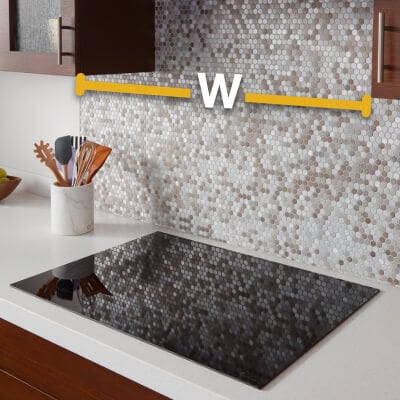
Step 2: Measure the width of the area between the cabinets
Measure the width of the area over the range or cooktop. Range hoods often come in 24, 30 or 36 inch widths. The hood should be at least as wide as the cooking surface, but preferably should be 6 inches wider. Under-cabinet hoods and over-the-range microwave hoods should fit snugly between cabinets while canopy hoods can be installed either flush or with a few inches of space on either side of the hood.
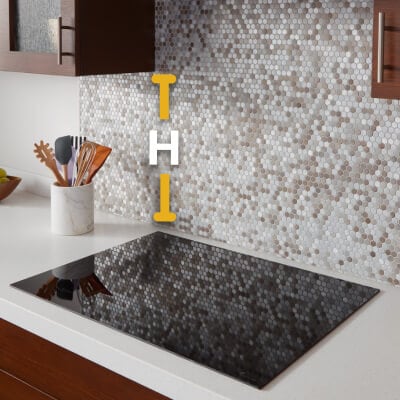
Step 3: Measure the height of the space above the cooking surface
Make sure you have enough space between the cooking surface and bottom of the hood. Be sure to consult local building codes and the manufacturer’s recommended installation heights for your cooking appliance. Here are some typical clearances for reference:
20 inches minimum for an electric range or cooktop
24 inches minimum for a gas range or cooktop
No more than 36 inches for both gas and electric cooking surfaces
If you’re installing your hood under a cabinet, it’s okay if it’s not flush with the bottom of your cabinets as long as the correct distance to the cooking surface is retained. For retractable downdraft hoods, make sure there is enough unobstructed space above the cooking surface for the vent to extend fully. If you have limited space above the range but would like a microwave hood combination, check out the Low Profile Microwave Hood Combination by Whirlpool brand, a shorter over-the-range microwave that can fit in the same space as an under-cabinet hood.
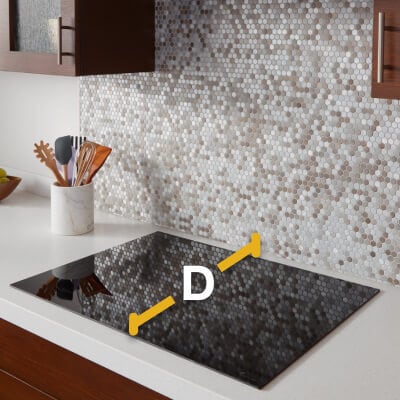
Step 4: Measure the depth of the cooking surface
Measure the cook surface from front to back, excluding the control panel or trim. Vent hoods should be deep enough to provide adequate coverage for the front and rear burners. Commercial and oversized ranges may require custom or specialized range hoods. If installing a downdraft vent, make sure the cabinet below is at least 24 inches deep. Some installations may require a countertop depth greater than 25 inches.
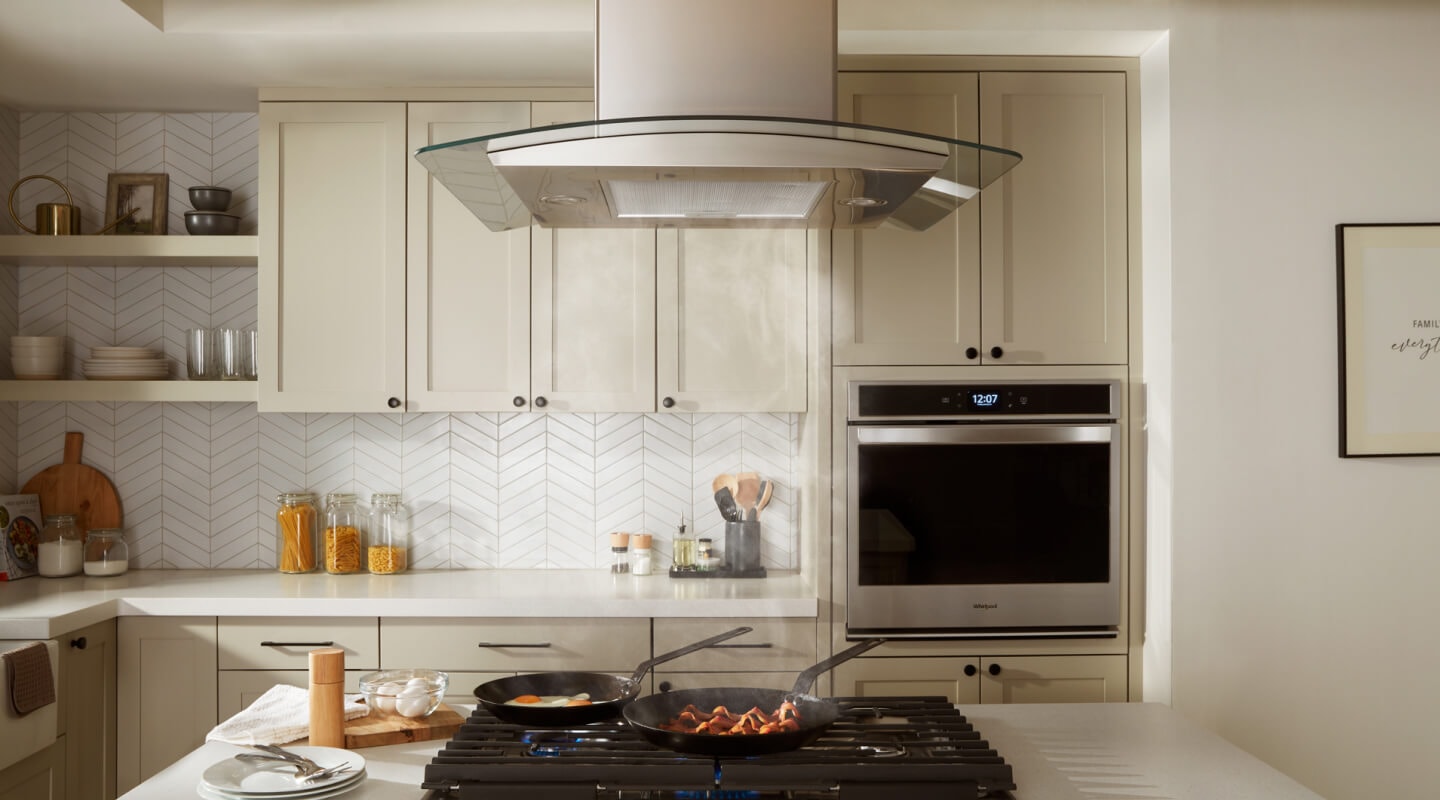
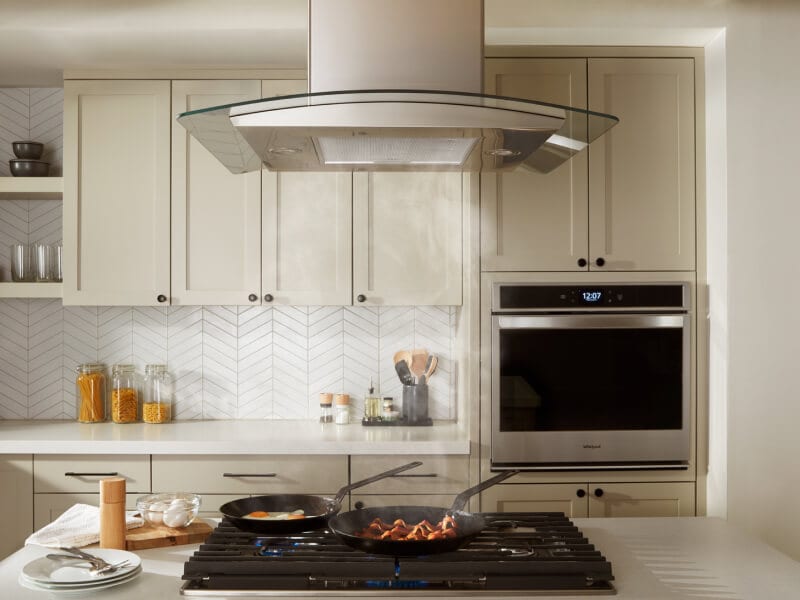
What to consider other than range hood dimensions
Once you’ve determined which size range hood will best fit in your kitchen, consider the following range hood features to find the option that will work best for you.
Venting strength (CFM Motor Class)
Venting strength, or airflow capacity, is measured in cubic feet per minute (CFM). A higher number indicates a greater capacity to replace kitchen air at a higher frequency. In general, 200 to 300 CFM Motor Class is a good number to aim for if you’re cooking everyday meals and have a residential range. Oversized or commercial-style ranges may require greater venting capabilities.
To make sure you get the right venting strength, check the manufacturer’s recommendations for your cooking appliance. Also keep in mind your cooking habits, the overall size of your kitchen and local construction code requirements.
Style
Canopy-style hoods come in a variety of shapes and styles. They are often shaped like an upside-down funnel or capital T, but sometimes have more of a dome shape. Some models include glass canopies, LED accents and other stylized elements.
Recirculating vs. external venting
Some range hoods vent externally, which means they vent kitchen air outside and require ductwork in the wall, ceiling or floor. Ductwork needs to be professionally installed if it doesn’t already exist. Ductless, or recirculating venting, filters the air, and then recirculates it back into the kitchen. These can be installed anywhere, but the filter will need to be cleaned at least twice a year or more frequently to maintain optimal performance depending on your cooking habits. Some hoods are convertible and can vent externally or through recirculation.
Most decorative hoods, like these Whirlpool brand canopy and downdraft styles, vent externally. Most under-cabinet and microwave hood combinations come factory set to recirculate air in the kitchen. Always check the appliance’s owner’s manual or specifications to understand how your hood vents and if it’s convertible. Also, it is important to look at kitchen hood liners and blowers, as they sit within the ducts of your vent hood to draw smoke and odors out and help keep your ventilation system running smoothly. Learn about other parts and accessories for range hoods.
Explore Whirlpool® Vent Hoods for your kitchen

Get more with a Whirlpool account
Sign in and explore
Was this article helpful? Pass it on
Get more help finding the right cooking appliances


home heartbeat
Ready for more tips, home hacks and appliance guides?



